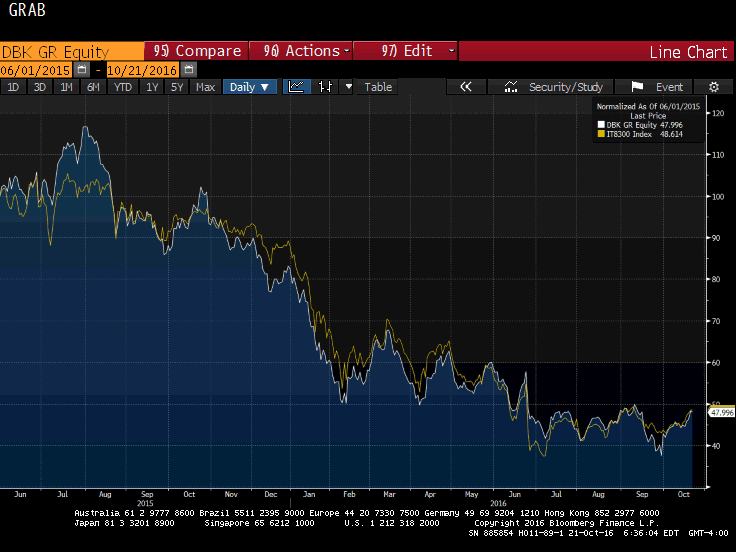Summary:
DB and Italian bank stocks have been moving in tandem.
They suffer from fundamentally different problems.
The euro has been selling off as the bank shares rebound.
| European banks may not be the main driver of the investment climate, but their challenges are not resolved. Investors have focused on two country’s banks recently. Germany’s Deutsche Bank and Italian banks more generally.
This Great Graphic, made on Bloomberg, show how closely the two have moved in tandem. The white line is Deutsche Bank share, while the yellow line is an index of Italian bank shares. The price of both have been indexed to begin June 2015 at 100. Despite the co-movement, Deutsche Bank’s challenges are dramatically different than Italian banks. The latter have been weighed down by non-performing loans, but also the prolonged period of weak growth when not contracting. The former’s immediate challenge is the fine from the US Department of Justice for improper activity in the US residential mortgage market. The fine would overwhelm the bank’s litigation fund. Deutsche Bank’s business model is not as reliant on loans as Italian banks, and there does not appear to be an NPL problem. Investors appear more concerned about the valuation of its assets. Given the size of Deutsche Bank’s derivatives exposure (~ gross $40 trillion), the potential contagion effect could be extensive. Italian bank woes are mostly a domestic phenomenon. Through this week, Deutsche Bank shares have advanced four consecutive weeks.During this streak, the share price has rallied 15.5% and is back to where is was when the US fine was announced. Italian bank shares are up for the sixth consecutive session today and putting the final touches on the third weekly advance. During this run, the index is up nearly 11%. |
Deutsche Bank Share and Italian Bank Shares Compared |
The Stoxx index of European banks has also risen for three consecutive weeks for about a 9.5% increase. This index has only been down in two of the last nine weeks. The rolling 60-day correlation between the percent change of this European bank index and the Italian bank index is near 0.94. One explanation is that Italian banks are a risk asset par excellence, and they do what European banks do but more so. This, in turn, suggests that addressing Italy’s challenges requires resolving European’s problem.
Lastly, when news of the US fine on Deutsche Bank was announced, and the pressure on shares mounted, many expected the euro to fall. It moved sideways. With this week’s loss, the euro has fallen for three consecutive weeks, while Deutsche and Italian bank shares have advanced. The main weight on the euro appears to be the divergence of monetary policy. Although it may not have been discussed at yesterday’s ECB meeting (or the previous meeting), the market is confident that the ECB will extend its asset purchases. At the same time, the pendulum of market sentiment has swung toward a Fed rate hike at the December FOMC meeting.
Full story here Are you the author? Previous post See more for Next post
Tags: Deutsche Bank,ECB,Germany,Great Graphic,Italian Bank,Italy,newslettersent








































